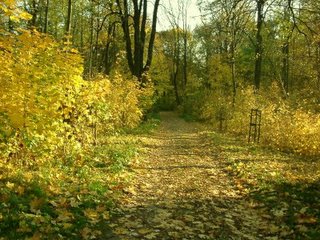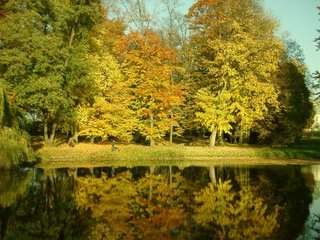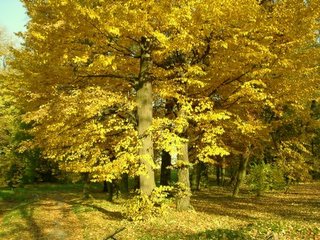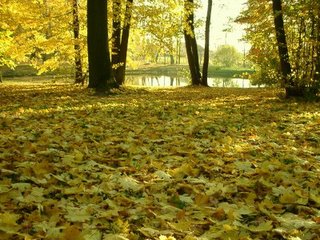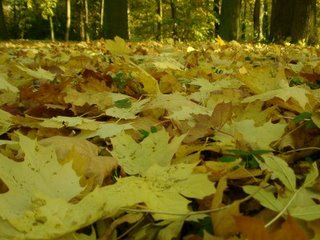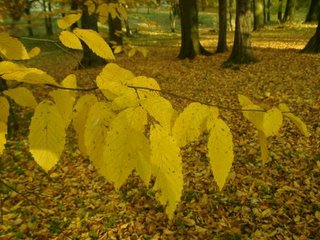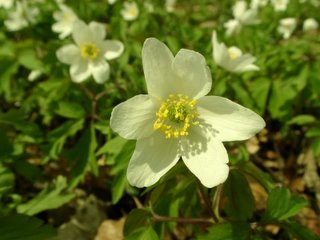my-own-planet-Earth
Sunday, October 30, 2005
Friday, October 28, 2005
Geophytes
That's me again. Today I would like to announce that I have written two interesting articles lately and they will be published soon. First, longer, is about geophytes in a park that is nearby my home. This park is very nice and soon I will write more things about it here for sure. Though some facts should be already known. For example I have described some trees that occur there in the entry from 5 October 2005 in this blog of mine.
Now, we have autumn in Poland and soon winter will come but thinking about next spring I delivered two things I wrote last spring some days ago to my favourite editor and I am very happy they were accepted.
First article is about geophytes generally and then I described four particular geophytes that are widespread within the park. There are: Anemone nemorosa, Ficaria verna, Scilia bifolia and Gagea lutea. Second article is about a new mass location of Hepatica nobilis in a deciduous forest close to my hometown. There are plenty of liveworts in the spring there and is really hard to miss these flowers in this place.
Look at the picture beneath and admire Polish spring plants:)
1. Anemone nemorosa
3. Scillia bifolia
4. Hepatica nobilis

 In the meantine I will try to make some shots of Polish trees in the autumn. I don't think anything as beautiful as Polish golden autumn is anywhere all over the world!
In the meantine I will try to make some shots of Polish trees in the autumn. I don't think anything as beautiful as Polish golden autumn is anywhere all over the world!
To be continued soon:)
Sunday, October 23, 2005
Częstochowa - different point of view
Hi:)
So I would like to encourage to read everyone about the other picture of Częstochowa region:)
The region of Częstochowa occupies mainly the north-west part of the Silesia Cracow Uplands, which is surrounded from three sides by the Middle Poland lowlands and streches out to reach the little Poland eastwards.
Geographically, the region of Częstochowa lies within two tectonical units of the Alpine origin, predominantly in the Silesia Cracow monocline and, in the small eastern part, in the Nida basin.
The whole Mosezoic Sedimentary cover reclines on the strongly tectonically disturbed, folded and faulted Paleozoic substratum represented by Silesian, Devonian, Carboniferous, Permian deposits of the variscian orogenisis.
The monocline consists of chronologically composed stratification of Mesozoic formations (the Triassic, Jurassic, Cretaceaus periods) which slope down at the mean angle of 20.
to be continued soon:)
Monday, October 17, 2005
Back into mountains:)
It's a long time since I wrote about mountains in my blog last time. Today I have another day of missing mountains that's why I would like to present you a short article about Andes. Why about Andes? Because everyone should know that in spite of the fact Himalaya mountains are the highest presently, there are young Andes that grow higher and higher very fast so in some thousands/millions years Andes will be higher than Himalaya that are already getting older at the moment.
The Andes Mountains are located in South America, running north to south along the western coast of the continent. The latitude is 10° N. to 57° S. The longitude is 70° W. to 80° E.
The Andes Mountains are one of the longest and one of the highest mountain ranges in the world. They are located in South America and stretch 4,500 miles from north to south, along the west coast of the continent.
The climate is not the same throughout the biome because there are places nearer to the equator than others. The Andes are separated into three natural regions: the southern, central, and northern regions. In the northern region, it is hotter because it is closest to the equator. There are rain forests in this region, due to the more humid, rainy climate. In the southern region, the mountains are nearer to the Antarctic and it is much colder. It is not very populated in the southern area.
In the central region of this biome, the weather is more mild because it is not near either the equator or the cold Antarctic. The largest herb in the world, Puya raimondii, grows in this region and can survive at high elevations up to 13,000 feet. The herb can also live for 100 years. The herb's leaves all grow from one big stem, which allows for moisture to run down the leaves to the base of the plant. So during times of drought, the plant can survive.
Many of the plants which grow in the Andes Mountains are small in size to conserve energy. Their leaves can be stiff and strong to protect them from frost and cold weather if they are high in the mountains.
The Andes Mountains supply many birds with homes like the Flamingo, Andean Flicker, the Condor, and the Hillstar Hummingbird. Types of land animals include the Mountain Lion, the Red Perll, and Llamas to name a few. The Spectacled Bear also lives in this biome. The Giant Toad and Andean Iguana are some examples of reptiles. This iguana is one of the few lizards found in that cold climate.
The Andes Mountains are hurt by humans because they cut down trees which shelter many unique Andean animals. Man also mines for gold, silver, and copper which then erodes the soil and hurts the plants of the Andes.
by Alan W. 2002
Wednesday, October 12, 2005
Some interesting links
1. great www with detailed and comprehensive description of US national parks
http://www.us-national-parks.net/
2. good www sites about australian national parks
http://www.atn.com.au/parks/parks.htm
3.some info about national parks of New Zealand
http://www.newzealand.com/travel/destinations/
national-parks-home.cfm
4.and last but not least – Canadian national parks in both English and French version:
http://www.pc.gc.ca/index_e.asp
Hope to see you soon:)
Sunday, October 09, 2005
Two new maps
Soon more news:)
Beskid Śląski
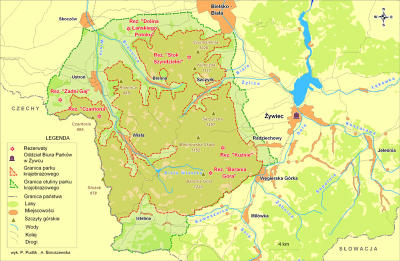
Beskid Żywiecki
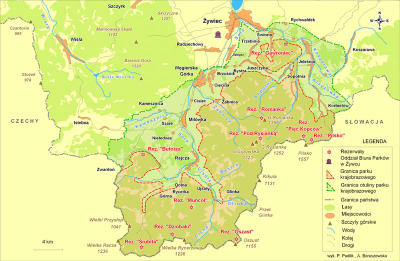
Wednesday, October 05, 2005
Trees in my Park
Today I would like to put some trees that appear in Park nearby my house. I like this place very much - look and admire:)
1. Pinus strobus
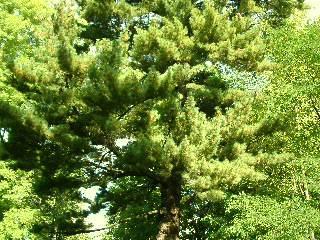 2. Robinia pseudoacacia
2. Robinia pseudoacacia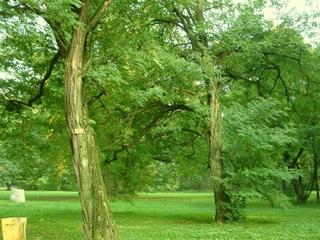 3. Salix alba
3. Salix alba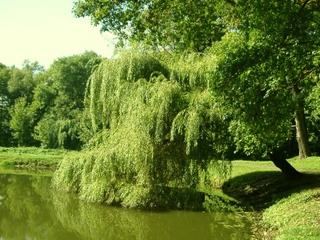
4. Larix decidua
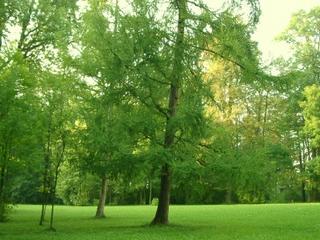
5. Acer pseudoplatanus
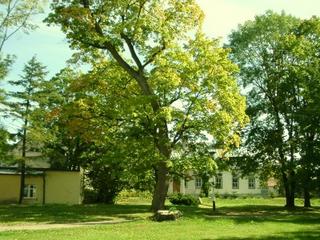 6. Quercus robur
6. Quercus robur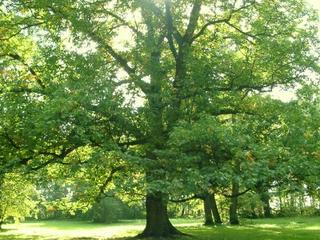 7. Carpinus betulus
7. Carpinus betulus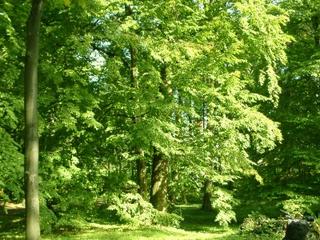 8. Fagus sylvatica and Fraximus excelsior
8. Fagus sylvatica and Fraximus excelsior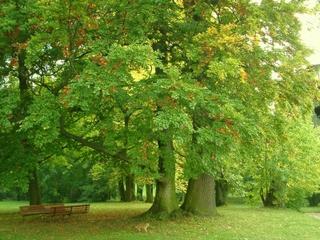
Soon I will write more about these trees:)
Read me soon:)
Saturday, October 01, 2005
The Celts
Here I found some very interesting links about this topic where you can read and trace on appropriate time-line that this racial group that we now call Celt were in fact Indo-European people whose culture spread rapidly across the whole of Europe, up into Scandinavia, down into the Spanish peninsula; and modern thought points to a spread over the Asian sub-continent as far as the borders of China about 1000-750 years before Christ.
On the same time-chart then we can find times of Greek and Roman culture that dominated Europe and the Celts who left continent for Ireland and British Islands (where they are mostly attached to nowadays and we can find most of information about Celts from these areas - though previously Celtic tribes had been widespread over whole Euro-Asian continent before they found their place on Irish islands).
Read also this text:
http://www.wsu.edu:8080/~dee/MA/CELTS.HTM
and:
http://www.suite101.com/article.cfm/celtic_myths/112296
That was a very short entry of mine. Next will be about Polish trees.
You are welcomed to read it:)

